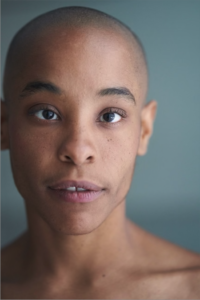
Jasmine Hearn Performs at Moody Center for the Arts on November 5
The dancer's latest composition is inspired by artist Kapwani Kiwanga.

When Jasmine Hearn speaks, one is drawn to the gentle, lyrical quality of their voice. And then the power of their words sinks in.
Despite a diminutive artist-dancer’s demeanor, Hearn is a force of nature motivated by the authority of truth. And what could be more powerful than that?
As an artist, choreographer, and performer whose themes often respond to traditional constructs of gender, how do they describe themselves? “I am an interdisciplinary artist, and I identify as a Black, queer, lesbian witch. I am also a memory-keeper—a living, breathing memorial to our elders, particularly Black women and Black mothers,” Hearn, who uses they/them pronouns, explains with characteristic tender strength.
As you may suspect, Hearn is not a Dancing with the Stars sort of performer. “My commitment to dance is expansive. It includes movement, yes, but also sound-conjuring and storytelling often stemming from the history of the location I am in, the Earth, or architecture. I try to be a truth-teller, to speak honestly in everything I do. I was fortunate to learn at an early age to say what I mean, and it serves me well now.”

The native Houstonian, who was reared in Acres Homes, is delighted to be returning to their hometown after performing around the country and living in New York City. “It feels wonderful to be here. Growing up, I was surrounded by so many amazing, passionate women—my mom, sisters, cousins, aunts. I was engulfed in astounding women, and returning to it feels very nurturing.”
On November 5, Hearn will perform their composition inspired by artist Kapwani Kiwanga at a free Moody Center for the Arts event on the Rice University campus. The audience can expect to see a uniquely improvisational performance that combines music, text, and movement. A reviewer in New York City marveled at how the performance takes on a different appearance each time Hearn (and the audience) move through the space.
This innovative dancer has a long list of credentials and collaborations with a who’s-who of multidisciplinary artists, from childhood friend Solange Knowles to Alisha Wormsley, Vanessa German, Ayanah Moor, Holly Bass, and Li Harris.
Hearn recently won a Bessie Award—their third—for Outstanding Performance, based on their collaborative work in the streets of New York City. Other venues include New York’s Guggenheim Museum, The Getty Center in Los Angeles, and in Houston with Dance Source Houston.

Artist Kiwanga’s Moody Center exhibition that will inspire Hearn’s performance is entitled Kapwani Kiwanga: The Sand Recalls the Moon’s Shadow. It is Kiwanga’s first show in Houston, and consists of two installations focusing on aspects of two widely differing economies—the Tanzanian sisal trade (and the role it played in Tanzania’s independence), and the Texas fracking industry (and its environmental impact). The installations focus on how nations exploit their natural resources.
Moody Center for the Arts has proven to be a vital addition to Houston’s arts scene since its launch in 2017. The 50,000-square-foot, $30 million building is a venue for presenting works in all disciplines, a teaching space, and a forum for local, national, and international artists. The Center’s mission is to foster creative thinking, original expression, and promote campus and community collaboration through encounters with the arts.
Alison Weaver, the Susan Deal Booth Executive Director of the Moody Center, describes the collaboration with Hearn and Kiwanga: “By extending open-ended invitations to artists like Jasmine and providing a platform for the public to experience their engagement with the works on view, we hope to inspire new connections between art and ideas, and between visionary artists and Houston audiences.”
When Hearn is not performing, they are often teaching others who have stories to tell. “Teaching, for me, is a way to learn with others. I appreciate the opportunities to share and connect memories and dreams with movement and sound. Black writer and feminist Audre Lorde [believes that] if we are to survive, we must also teach. I take that to heart,” Hearn concludes, quietly.
For more information about Jasmine Hearn’s performance or other Moody Center for the Arts events, visit moody.rice.edu.











Comments